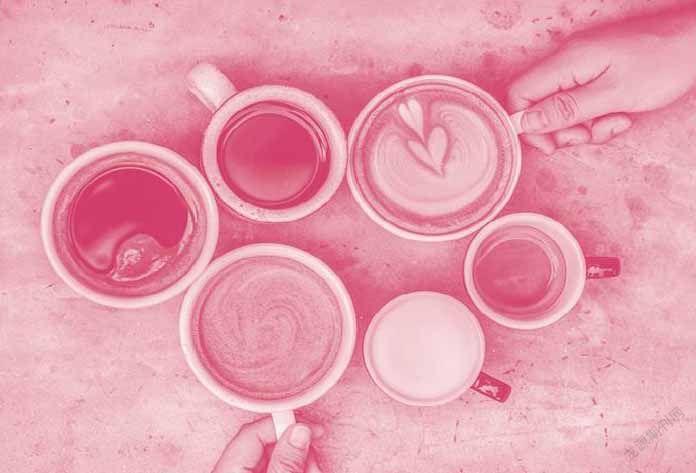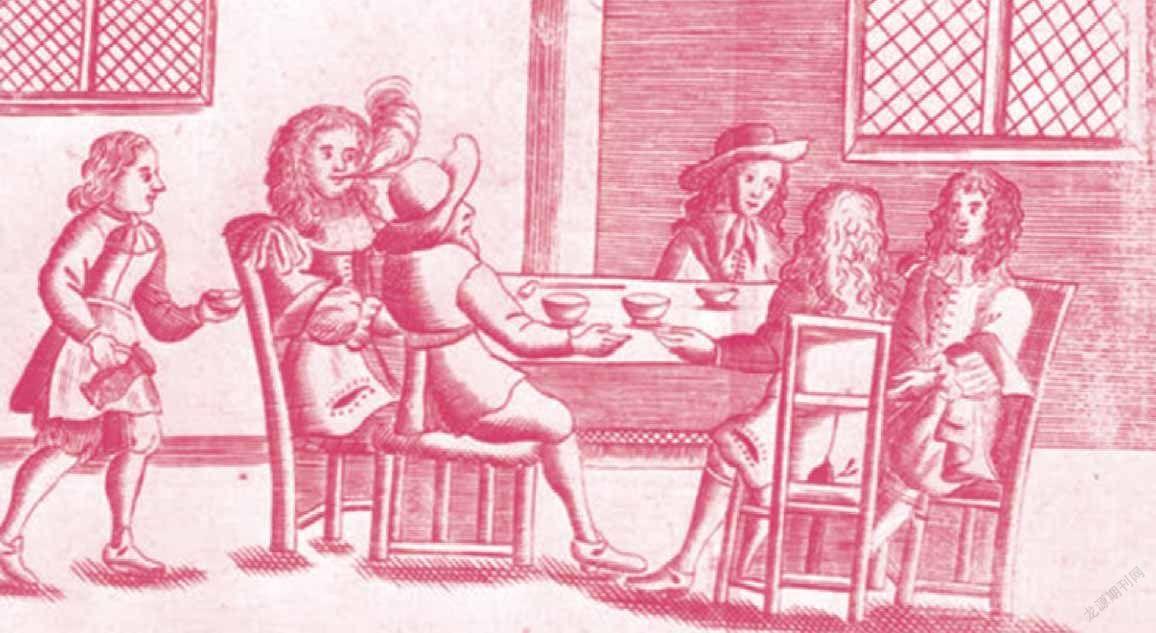A Drink for the Devil魔鬼的饮料
2019-09-10保罗·克里斯特尔姚海涛
保罗·克里斯特尔 姚海涛


Coffee is the second-most traded commodity in the world, behind only petroleum, and has become a mainstay of the modern diet. Believed to have originated in Ethiopia, coffee was used in the Middle East in the 16th century to aid concentration. But did you know it also sparked a social revolution in Britain in the 17th century? Here are six facts about the history of coffee…
1. Coffee may have been discovered by ‘excited goats’
Legend has it that Kaldi, a lonely goat herder in ninth-century Ethiopia, discovered the energising and invigorating1 effects of coffee when he saw his goats getting excited after eating some berries from a tree. Kaldi told the abbot2 of the local monastery about this and the abbot came up with the idea of drying and boiling the berries to make a beverage. He threw the berries into the fire, whence the unmistakable aroma of what we now know as coffee drifted through the night air. The now roasted beans were raked from the embers3, ground up and dissolved in hot water: so was made the world’s first cup of coffee.
The abbot and his monks found that the beverage kept them awake for hours at a time—just the thing for men devoted to long hours of prayer. Word spread, and so did the hot drink, even as far afield4 as the Arabian peninsula.
2. It was brewed by a saint from Mocha
An alternative story has us believe that coffee was first discovered by sheik5 Abou’l Hasan Schadheli’s disciple Omar. While in exile from Mocha6 (Arabia Felix in present-day Yemen), Omar, who was famous for his ability to cure the sick through prayer, lived in a desert cave near Ousab. Somewhat hungry, Omar one day chewed some berries only to find them bitter. He roasted them but this only made them hard; finally he tried boiling them, resulting in a fragrant brown liquid which, in an instant, gave him unnatural and exceptional energy and allowed him to stay awake for days on end. His ‘miracle discovery’ was held in such great awe7 that he was allowed to return home to Mocha and elevated to the sainthood while coffee percolated8 throughout the Arab world.
By the 16th century, coffee was the beverage of choice9 in Persia, Egypt, Syria and Turkey, its reputation as the ‘wine of Araby’ boosted no end by the thousands of pilgrims visiting the holy city of Mecca each year from all over the Muslim world. Yemeni merchants took coffee home from Ethiopia and began to grow it for themselves. It was prized by Sufis in Yemen who used the drink to aid concentration and as a spiritual intoxicant. They also used it to keep themselves alert during their nighttime devotions.
From the Middle East the popularity of coffee soon spread through the Balkans, Italy and to the rest of Europe, east to Indonesia and then west to the Americas, largely through the Dutch.
3. Coffee forged a social revolution
Coffee was so powerful a force that it forged a social revolution. Coffee was drunk in the home as a domestic beverage but, more significantly, it was also drunk in the ubiquitous public coffee houses10—qahveh khaneh11—which sprang up12 in villages, towns and cities across the Middle East and east Africa. These coffee houses soon became all the rage and were the place to go to socialise. Coffee drinking and conversation were complemented by all manner of entertainment: musical performances, dancing, games of chess and, most crucially, gossiping, arguing and discussing the breaking news of the day (or night). These coffee houses soon became known as ‘schools of the wise’, the place you went to if you wanted to know what was going on in your world. The link between coffee and intellectual life had been established.
4. It was believed that coffee is ‘sinful’
Coffee, like alcohol, has a long history of prohibition, attracting fear and suspicion and religious disquiet and hypocrisy. Had the zealots (of all religions) got their way13 then there would not be very many coffee houses open today.
Coffee drinking was banned by jurists and scholars meeting in Mecca in 1511. The opposition was led by the Meccan governor Khair Beg, who was afraid that coffee would foster opposition to his rule by bringing men together and allowing them to discuss his failings. Thus was born coffee’s association with sedition14 and revolution. It was decreed sinful (haraam15), but the controversy over whether it was intoxicating or not raged on over the next 13 years until the ban was finally rescinded16 in 1524 by an order of the Ottoman Turkish Sultan17 Selim I, with Grand Mufti18 Mehmet Ebussuûd El-İmadi issuing a fatwa19 allowing coffee to be drunk again. Beg was executed for his troubles by command of the Sultan himself, who further proclaimed coffee to be sacred. In Cairo there was a similar ban in 1532; coffee houses and coffee warehouses there were ransacked.
5. Coffee was known as ‘the devil’s cup’
It did not take long for coffee to travel the short distance to the European mainland where it was landed first in Venice on the back of the lucrative trade the city enjoyed with its Mediterranean neighbours. Initially, however, coffee met with the suspicion and religious prejudice it had suffered in the Middle East and Turkey. The word on the street20, filtering back from intrepid21 European travellers to the mysterious and mystical lands of the east, was of an equally mysterious, exotic and intoxicating liquor. To Catholics it was the ‘bitter invention of Satan’, carrying the whiff22 of Islam, and it seemed suspiciously like a substitute for wine as used in the Eucharist23; in any event, it was outlawed.
Such was the consternation that Pope Clement VIII had to intervene: he sampled coffee for himself and decreed that it was indeed a Christian as well as a Muslim drink. On tasting it he wittily declared: “This devil’s drink is so delicious… we should cheat the devil by baptising it!” From then on, coffee has been dubbed the devil’s drink, or the devil’s cup.
6. Coffee came to England in the mid-17th century
According to Samuel Pepys, England’s first coffee house was established in Oxford in 1650 at The Angel24 in the parish25 of St Peter-in-the-East, by a Jewish gentleman named Jacob, in the building now known as The Grand Cafe. London’s first coffee house opened in 1652 in St Michael’s Alley, near St Michael at Cornhill’s churchyard. It was run by Pasqua Rosée, a Greek man who in 1672 also set up a coffee stall in Paris. Pepys visited the London coffee house on 10 December 1660: “He [Col.26 Slingsby] and I in the evening to the Coffee House in Cornhill, the first time that ever I was there, and I found much pleasure in it, through the diversity of company and discourse.”
全球贸易量最大的商品是石油,其次便是咖啡,后者已成为现代饮食的一大支柱。据说,咖啡源自埃塞俄比亚;16世纪的中东人借其提升专注力。但是,你可知道,咖啡还曾在17世纪的英国引发一场社会革命?以下6点,乃是咖啡史纪实。
1. 或由“亢奋山羊”引导发现
传说在公元9世纪,埃塞俄比亚有个叫卡尔迪的孤单牧羊人,他看到自家羊儿吃了树上的浆果后亢奋不已,发现咖啡能够使人活力倍增、精神焕发,便将此事告知当地修道院院长。院长想到把浆果烤干,煮成饮料。他将浆果投入火中,随后一阵香气飘出,沁透夜空,与当今咖啡的味道别无二致。烘烤罢,他从余烬中耙出豆子,磨碎后放入热水溶解:世界上第一杯咖啡就此诞生。
院长和修道士们发现,这种饮料能让自己连续几小时不犯困——长时间专注祈祷者恰需此物。消息不胫而走,该热饮也随之传播,甚至传到遥远的阿拉伯半岛。
2. 穆哈某圣徒首制咖啡
还有个故事称,咖啡最早由谢赫阿布·哈桑·查德赫利的追随者奥马尔发现。奥马尔以祈祷医病著称,曾被逐出穆哈(在现今的也门),流亡期间栖身于乌萨布附近的荒漠洞窟。一天,他觉得有点儿饿,就嚼了些浆果,只觉味道苦涩。他把浆果烤了烤,结果变得硬邦邦的。最后,他试着将其煮沸,熬制出一种棕色液体,香气十足,他喝后获得了一种奇异的能量,使他连续几天睡意全无。此项“神奇发现”令人敬畏无比,所以他获准归乡,回到穆哈,并升为圣徒,而咖啡也在阿拉伯世界广为流传。
一直到16世纪,咖啡都是波斯、埃及、叙利亚和土耳其的首选饮品。圣城麦加每年有数千名穆斯林朝圣者,盛赞其为“阿拉伯葡萄酒”。也门商人从埃塞俄比亚把咖啡带回去种植,供自己享用。也门的苏菲派人士则用这种饮料提升专注力,并将其作为精神麻醉剂,对它大为赞赏。他们还在夜间祈祷时借助咖啡怡神醒脑。
很快,咖啡从中东传出,风靡巴尔干地区,继而进入意大利和欧洲其他地区,接着向东传入印度尼西亚,而后又主要通过荷兰人向西传入美洲。
3.推动社会变革
咖啡威力无穷,推动了一场社会变革。咖啡不仅走进千家万户,成为家常饮品,更重要的是,它还催生了随处可见的公共咖啡馆。这些咖啡馆出现在中东和东非各村镇及城市,很快风靡一时,成为社交之所。人们边饮咖啡边聊天,还有各种娱乐助兴,如音乐演出、舞蹈、国际象棋等,其中最关键的是,议论当天(或当晚)的重大事件,发表见解,交流看法。很快,这些咖啡馆被称作“智者学园”,若想了解时事,便要到此一游。咖啡与智识生活已然有了关联。
4.曾被视作“邪恶之物”
咖啡和酒精一样,曾长时间遭禁;引起恐惧与怀疑,也令宗教界不安并显露出虚伪的一面。如果当时宗教(此处指各路宗教)狂热分子得逞,如今就不会有这么多咖啡馆营业。
1511年,法学家与学者在麦加会面,将咖啡列为禁品。这些反对者的领头人是麦加市市长海尔·贝格,他生恐咖啡会引得民众聚议其过失,进而反对其统治。咖啡与煽动和革命的关联由此产生。当局判定咖啡为邪恶之物。但是,在接下来的13年里,人们就咖啡是否致醉激辩不休。直到1524年,奥斯曼土耳其苏丹塞利姆一世下旨解禁,大穆夫提穆罕默德·埃布苏德·埃伊马迪发布诏书,允许人们饮用咖啡,这场争议才休止。因貝格滋生事端,苏丹下令将其处决,进而将咖啡奉为圣物。1532年,开罗也有类似禁令;那里的咖啡馆与咖啡货栈均遭洗劫。
5.曾获称“魔鬼饮品”
不久,咖啡就传到了邻近的欧洲大陆。由于在威尼斯及其地中海邻城进行贸易利润丰厚,咖啡首先落足此地。然而,正如当年在中东和土耳其的境况,咖啡一开始也受到质疑,遭遇宗教偏见。从勇敢的欧洲旅者到神秘莫测的东方国度,坊间传言散播各处,说咖啡如东方般神秘莫测,是一种致醉的异域烈酒。对天主教教徒来说,它是“撒旦酿的苦汁”,透着伊斯兰教的气息,而且与圣餐中的葡萄酒有混同之嫌;无论如何,法不能容。
咖啡引起如此恐慌,教皇克雷芒八世不得不进行干预。他亲自品尝咖啡,认定其既属于伊斯兰教,也归于基督教。品尝时,他巧妙地宣布:“魔鬼的饮料美味无比……我们应当为它施洗,欺骗魔鬼。”从那时起,咖啡就被称为“魔鬼的饮料”,也叫“魔鬼饮品”。
6. 17世纪中叶传入英格兰
据塞缪尔·佩皮斯记载,英格兰首家咖啡馆由犹太绅士雅各布于1650年创建于牛津,位于城东圣彼得教区天使旅店,如今该栋建筑名为“大咖啡馆”。伦敦首家咖啡馆则建于1652年,位于圣米迦勒巷,附近是康希尔街上的圣米迦勒教堂墓园。其创办者为希腊人,名叫帕斯夸·罗赛,他还于1672年在巴黎摆了咖啡摊。1660年12月10日,佩皮斯到伦敦造访这间咖啡馆,他写道:“晚上,我和斯林斯比上校去康希尔街的咖啡馆,那是我第一次来这个地方。这里的人形形色色,无所不谈,我感到其乐无穷!” □
(译者为“《英语世界》杯”翻译大赛获奖选手,单位:南京航空航天大学)
